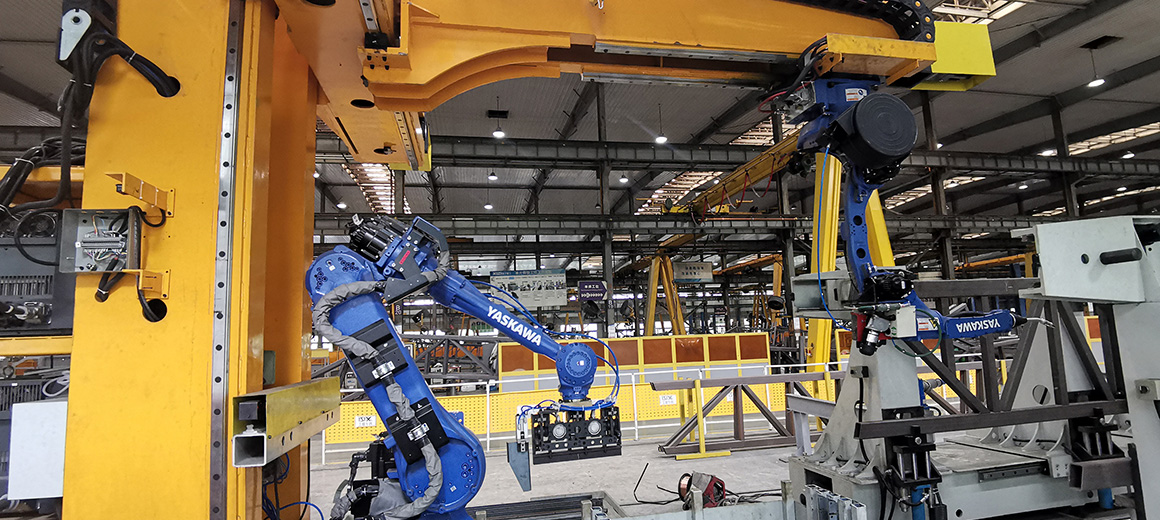

Robot-based welding system increases processing quality and reduces workload
With the first robot-based welding system for elevator girders, XIZI Heavy Industry not only ensures a consistently high quality of safety-relevant welds, but welders are also relieved of strenuous and dangerous work while benefitting from significant productivity increases through PC-based control from Beckhoff.
XIZI Heavy Industry Co., Ltd. is a wholly owned subsidiary of XIZI United Holdings Co., Ltd.; one of the top 500 companies in China. The company's product range includes complete elevator systems, escalators, moving walkways and their accessories, including crossbeams, escalator side plates, drives and control systems, as well as elevator installation services and structural steel grids.
Higher quality, efficiency and safety
Usually, welding is done by hand, which is already arduous under normal conditions. However, to ensure consistent quality in welding seams, ventilation of the workshop is prohibited. Therefore, the welders have had to carry out demanding welding work at high temperatures and with poor ventilation – until now. With the help of PC-based control, WTEC, a system manufacturer from Beijing that specializes in welding technology, has developed and installed a fully automated robot-based system for XIZI. According to WTEC, this is the first time fully automated, robot-assisted welding has been used in the production of elevator crossbeams.
The system not only improves the working conditions for operators; it also takes the efficiency and quality of welds to a new level. PC-based control and EtherCAT play a major role in the 25-meter robot welding system. A C6920 cabinet Industrial PC from Beckhoff in conjunction with TwinCAT, various EtherCAT Terminals, AX5112 Servo Drives and AM8561 servomotors – controls all welding processes:
- welding robot mounted on a gantry axis
- clamping and lifting systems
- all upstream and downstream processes
The latter includes automatic loading and welding of the typical trusses of an elevator with their upper and middle beams, the small lower beams and the fixing plates of the aprons and glass clamps.
XIZI required the solution to manufacture almost all products and their variants in a single operation. Accordingly, the welding robot must be able to perform a wide variety of complex tasks:
- automatic loading and welding of the small lower beams and inclined beams of the truss
- automatic loading and welding of the glass clamping parts and the apron fixing plates
- automatic loading and welding of the central beam
- vertical and horizontal welding
- vertical upward welding
- various types of welding for changing positions and workpiece sizes
TwinCAT as the universal control software
A C6920 Industrial PC with TwinCAT control software is all that is needed to implement these demanding functions: PLC, HMI, NC motion control, welding robot control, automatic generation of teaching programs – all tasks run on a single control platform. This keeps the architecture of the control system simple and clear. The operator console communicates with the control system via the ADS protocol in TwinCAT; the remote I/Os of the lifting and clamping device and the robot's gantry axis via EtherCAT, and the welding robot used by WTEC via EtherNet/IP. Such heterogeneous network structures can be implemented easily with the open approach of PC-based control. If required, the standard Ethernet interface of the IPC could also be configured for other protocols.
In the production control program based on TwinCAT HMI, WTEC manages the processes of all welding types including all parameter sets for the welding robot. After selecting a program, the welding robot receives the parameter sets for the various welding processes. After each weld is completed, the parameter sets used by the robot are reported back and archived.
Documenting all welds is an important aspect in elevator construction, especially since the system produces elevator crossbeams for different manufacturers – mostly with their own specifications, material types and batch sizes. Due to the high functionality and flexibility of TwinCAT software and PC-based control, WTEC and XIZI can cover the entire range decisively.